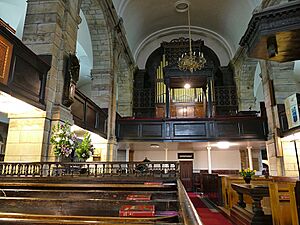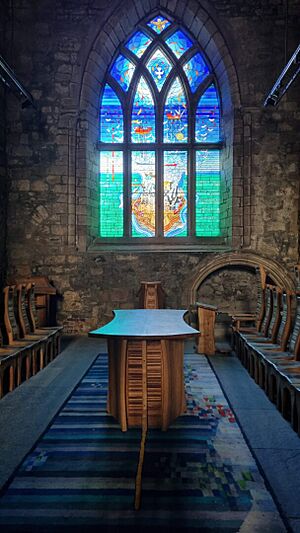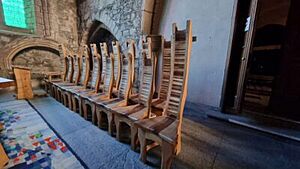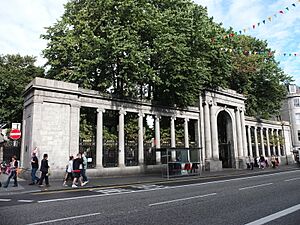Kirk of St Nicholas facts for kids
Quick facts for kids Kirk of St Nicholas |
|
|---|---|
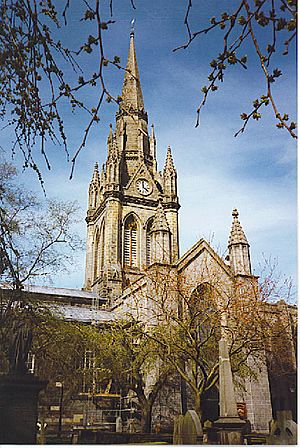
View from the kirkyard
|
|
| Location | Back Wynd, Aberdeen, AB10 1JZ |
| Country | Scotland |
| Denomination | Church of Scotland |
| Website | |
|
Listed Building – Category A
|
|
| Official name: The Kirk of St Nicholas Uniting (Church of Scotland and United Reformed) | |
| Designated: | 12 January 1967 |
| Reference #: | LB19966 |
| History | |
| Dedication | St Nicholas |
| Administration | |
| Presbytery | Aberdeen |
The Kirk of St Nicholas is a very old church in Aberdeen, Scotland. It was the first main church for the city. People in Aberdeen often call it the Mither Kirk, which means "mother church."
After a big change in religion called the Reformation, the church was split into two parts: the East Kirk and the West Kirk. These two parts joined back together in the 1980s. They became known as the Kirk of St Nicholas Uniting.
In 2020, the church stopped holding regular services. This happened when its members joined with another church, Queen's Cross Church. Today, the West Kirk part of the building is owned by a Scottish charity called Scot-ART.
Inside the church, there is a special area called the Oil and Gas Chapel. It has beautiful wooden furniture made by an artist named Tim Stead. There is also a colorful stained glass window. This window shows scenes of life in Aberdeen and was created by Scottish artist Shona MacInnes.
Contents
History of the Kirk
How the Church Began
The first time a church on this spot was mentioned was in a special paper from the Pope in 1151. Because Aberdeen is close to the sea, Saint Nicholas was chosen as the church's patron saint. Saint Nicholas is known as the patron saint of trade and sailors.
The church building was made much bigger in the 1400s. The Kirk of St Nicholas and St Mary's in Dundee were probably the largest churches in Scotland during the Middle Ages. Bishop Elphinstone officially opened the enlarged church in 1498. To celebrate 500 years since this event, a new stained-glass window was added near the main entrance.
Changes Over Time
The church has two special areas inside called the Drum Aisle and the Collison Aisle. These aisles separate the East and West parts of the church. They were once the "arms" (transepts) of the original 12th-century church. You can still see some parts of the old building from that time.
The West Church was built between 1751 and 1755. It was designed by James Gibbs in an Italian style. This part of the church was built where the old medieval nave (the main part of the church) used to be. The East Church was built later, in 1834, in a Gothic-revival style. It was built where the choir (the area for singers) used to be.
In 1874, a fire badly damaged the East Church and the old central tower. The tower had a tall spire and a set of nine bells. One of these bells, called Laurence or "Lowrie," was very large. The church was rebuilt, and a big granite tower was put up. A new set of 36 bells was installed in 1887 to celebrate Queen Victoria's Golden Jubilee. These bells were later replaced in 1950 with 48 new bells. This makes it one of the largest carillons (a set of bells played together) in the British Isles.
The Two Sanctuaries
The Kirk of St Nicholas is unique because it has two main worship areas under one roof. The old nave (main part) of the church collapsed around 1742. A new church, known as the West Kirk, was built in its place in 1755. This is the only building in Scotland designed by the famous architect James Gibbs. The West Kirk was used for regular worship until 2020.
The East Kirk was rebuilt in 1837 by Archibald Simpson. It had to be rebuilt again after the fire in 1874. Today, a lot of repair and archaeological work is happening in the East Kirk. Workers have found foundations of older parts of the church, many medieval burials, and old pieces of the building.
The Oil Chapel
The Oil Chapel was officially opened in 1990. This marked 25 years since oil was first discovered in the North Sea. The chapel has a special book of remembrance. This book lists the names of people who have died while working offshore in British waters.
Even with all the changes over the years, St Nicholas still has more medieval statues than any other church in Scotland. However, these statues are not in their original places. There is also a very old underground room called the Vault or Chapel of Our Lady of Pity. It has been repaired on the outside, but its medieval arched ceilings are still inside. This vault also holds many old wooden items from the late Middle Ages and the 1600s.
The area that used to be the Kirk of St Nicholas Parish is now part of St Mark's Parish. The West Kirk is now owned by a Scottish charity called Scot-ART, which took over in 2024.
Churchyard Features
The churchyard, or graveyard, surrounds the church on three sides: north, south, and west. It is very full on the west and south sides. Many of the gravestones are flat, like tables.
Unlike most Scottish graveyards, the stones here do not all face east. On the south side of the church, some flat gravestones are now part of the paving. They are even used for car parking, which is very unusual for a Scottish churchyard. The oldest monuments here date back to the mid-1600s.
The wall facing Union Street was rebuilt in the 1800s. It was made into a very formal row of columns, typical of the Georgian style.
Notable People Buried Here
Many important people are buried in the churchyard of the Kirk of St Nicholas. Some of them include:
- Alexander Anderson, a former leader of Aberdeen
- Sir John Anderson, a Scottish engineer
- John Henry Anderson, known as the "Wizard of the North"
- Rev Dr Thomas Blackwell, a principal of Marischal College
- Sir Thomas Blaikie
- Rev Andrew Cant, a well-known minister
- Archibald Simpson, a famous architect
- John Smith (architect), another important architect
Other Memorials
- A plaque for Rev Alexander Hetherwick.
- A plaque for Very Rev Mitford Mitchell, who was a minister here from 1878 to 1895. He also served as the Moderator of the General Assembly, which is a high position in the Church of Scotland.
Images for kids


